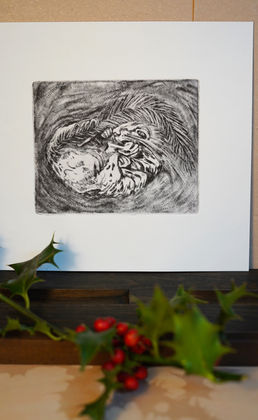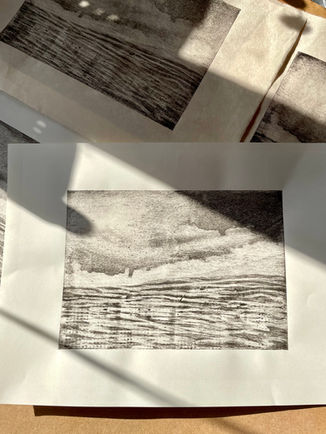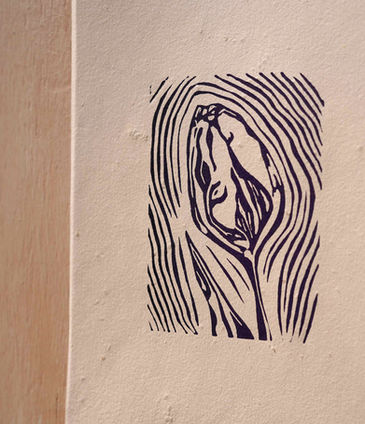DRYPOINT & COLLAGRAPHY
Drypoint is an intaglio printmaking technique which involves incising fine lines into a plate using a sharp point. This process creates a slightly raised edge to the line called a burr. When the plate is inked intaglio and wiped, this burr holds the ink and gives the print a distinctive velvety look. This burr is delicate and repeated printing will flatten it. For this reason, only small editions are produced, stopping before the burr is crushed. I often combine my drypoints with woodcut, linocut, monotype and collagraph plates.
Collagraphy is a very versatile printmaking technique which involves applying textures to a plate that can be printed either intaglio, relief or combination of both. I use offcuts of mountboard for my base and apply paints, recycled papers and reused fabrics to create the plate for printing.
MOKULITO
Mokulito is a planographic technique similar to stone lithography, but it uses wood as the plate instead of limestone. It was developed in Japan by Professor Seishi Ozaku in the 1970’s under the name Mokurito. Unlike traditional stone lithography, each print pulled will vary slightly due to the absorption qualities of the wooden plate. The dominance of the wood grain and its unique pattern all add to the final image and this will vary depending on the type of wood selected for use.
Mokulito is an exciting and transformative process which produces a small number of unique limited edition prints. This is in part due to the wooden plate degrading during the inking process and the unpredictable nature of using wood. In my work I like to use reclaimed wood where possible and add additional layers of linocut or monotype..
LINOCUT & SILKSCREEN
Linocut and Woodcut are relief printmaking process which use high quality steel gouges and V tools to carve away areas of the plate you do not wish to print. What remains is then inked using a roller and printed either by hand or using a press. I prefer to use traditional hessian backed linoleum as it is biodegradable.
Silkscreen printing uses finely stretched mesh on a frame which is called a screen. Historically the fabric used was silk (hence the name) but nowadays polyester is preferred. Ink is forced through the screen onto the paper below using a squeegee, this is called pulling a print.
There are several ways to create a stencil design on the screen. I prefer to cut paper stencils and use very limited amounts of hand painted screen filler if needed.















































